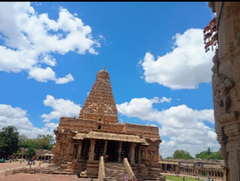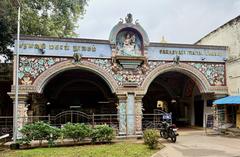
Thanjavur Meenakshi Sundareswarar Temple: Visiting Hours, Tickets, and Historical Significance
Date: 04/07/2025
Introduction
The Thanjavur Meenakshi Sundareswarar Temple stands as a remarkable emblem of Tamil Nadu’s religious and architectural heritage. Nestled in the historic city of Thanjavur, it is dedicated to Goddess Meenakshi, an incarnation of Parvati, and her consort Lord Sundareswarar, a form of Shiva. While often overshadowed by its more internationally known counterpart in Madurai, the Thanjavur temple offers a profound glimpse into Dravidian temple architecture and spiritual traditions. Its origins, referenced in Tamil Sangam literature as early as the 6th century CE, were shaped by the patronage of the Pandyas, Vijayanagara Empire, and Nayak rulers. Today, the temple complex is celebrated not only for its mythological and historical significance but also for its vibrant role in Tamil culture, hosting grand festivals that draw thousands of devotees and tourists (Britannica; Wikipedia).
This guide provides a comprehensive overview of the temple’s history, architectural marvels, visitor information (including hours, ticketing, accessibility), travel tips, and cultural significance. Whether you are a history enthusiast, spiritual seeker, or cultural explorer, the Thanjavur Meenakshi Sundareswarar Temple promises an immersive journey into South India’s sacred and artistic legacy.
Table of Contents
- Early Origins and Mythological Foundations
- Historical Development and Dynastic Patronage
- Architectural and Artistic Highlights
- Visiting the Temple: Hours, Tickets, Accessibility
- Cultural and Religious Significance
- Preservation and Modern Relevance
- Frequently Asked Questions (FAQs)
- Conclusion
- References
Early Origins and Mythological Foundations
Dedicated to Goddess Meenakshi and Lord Sundareswarar, this temple’s spiritual narrative is rooted in Hindu legend. Meenakshi, born to the Pandya king after penance, was destined to marry Shiva, who appeared as Sundareswarar. Their divine union is an annual focus of elaborate rituals and festivals (Britannica).
References to the worship of Meenakshi and Sundareswarar in Thanjavur appear in Tamil Sangam literature from the 6th century CE, underlining its ancient religious importance. The temple is also counted among the 275 Paadal Petra Sthalams, sacred Shiva temples celebrated in the hymns of the Saiva Nayanars (Wikipedia).
Historical Development and Dynastic Patronage
Pandya Dynasty Contributions
The core structures of the temple are attributed to the Pandya dynasty, particularly King Kulasekara Pandya (reigned 1190–1205 CE), who constructed the principal gopuram and sanctum. Their patronage established the temple’s layout and early Dravidian style, characterized by intricately carved pillars and granite edifices (Wikipedia; SamanyaGyan).
Medieval Turmoil and Restoration
The temple endured periods of destruction, notably during Malik Kafur’s 14th-century invasions, which led to significant damage and decline (SamanyaGyan). The Vijayanagara Empire played a critical role in its revival, undertaking extensive repairs and expansions that restored the temple’s prominence (Wikipedia).
Nayak Dynasty and Architectural Flourishing
The Nayak dynasty ushered in a golden era of temple architecture in the 16th–17th centuries. They expanded the complex, constructing the towering gopurams, pillared halls like the Thousand-Pillar Hall, sacred tanks, and vibrant murals. The southern gopuram, the tallest at over 170 feet, is adorned with thousands of vividly painted sculptures (Britannica). The Nayaks also established grand festivals, such as Meenakshi Tirukalyanam and the Teppa Festival (Facts.net).
Architectural and Artistic Highlights
The sprawling 14–15 acre temple complex is renowned for its Dravidian design. Four monumental gopurams, aligned to cardinal directions, serve as both spiritual gateways and visual landmarks (Indianetzone). The Thousand-Pillar Hall (with 985 intricately carved columns) and the Golden Lotus Tank are central features, while murals and stucco figures vividly portray Hindu cosmology (TempleYatri; Asia World Tour). The sanctums house unique idols, including Meenakshi’s emerald-hued black stone image.
Visiting the Temple: Hours, Tickets, Accessibility
Visiting Hours
The Thanjavur Meenakshi Sundareswarar Temple is open daily from 6:00 AM to 12:30 PM and 4:00 PM to 8:30 PM.
Tickets and Entry
Entry is free for all visitors. Special darshan or guided tours may require nominal fees and can be booked via the official temple website or authorized operators.
Accessibility
The temple provides ramps and accessible pathways in major areas, though some inner sanctums have steps. Assistance is available for elderly and differently-abled visitors.
Travel Tips
- Best Time to Visit: October to March for pleasant weather; April–May for vibrant festivals.
- Dress Code: Modest, traditional attire is required. Footwear must be removed before entering sacred areas.
- Photography: Allowed in outer courtyards and gopurams, but restricted in sanctums and during rituals.
Nearby Attractions
- Brihadeeswarar Temple (UNESCO World Heritage Site)
- Thanjavur Maratha Palace
- Saraswathi Mahal Library
Cultural and Religious Significance
The temple is a vital center for Tamil culture, spirituality, and the arts. It hosts classical music, dance, scholarly debates, and social welfare activities. Annual festivals like Meenakshi Tirukalyanam and Brahmotsavam draw thousands, showcasing processions, music, and rituals (TempleYatri; Cultural India). The temple embodies inclusivity and the revered status of the feminine divine in Tamil culture, reinforcing themes of unity, social balance, and cultural continuity (Trip Adventurer).
Preservation and Modern Relevance
Preservation efforts by the Archaeological Survey of India and local authorities ensure the temple’s architectural and artistic legacy endures (TempleGyan). The temple stands as a symbol of Tamil identity—its image featured on the state emblem—and remains a dynamic hub for worship, festivals, and cultural activities (Wikipedia).
Frequently Asked Questions (FAQs)
Q: What are the temple’s visiting hours?
A: 6:00 AM–12:30 PM and 4:00 PM–8:30 PM daily.
Q: Is there an entry fee?
A: Entry is free; nominal fees apply for special darshan or guided tours.
Q: Are guided tours available?
A: Yes; guides can be hired at the entrance or booked in advance.
Q: Can non-Hindus enter the temple?
A: Non-Hindus may access the temple complex but may be restricted from inner sanctums.
Q: Is the temple accessible for differently-abled visitors?
A: Yes, with ramps and assistance available in many areas.
Q: When is the best time to visit?
A: October–March for weather; April–May for festivals.
Q: Are photographs allowed?
A: Only in outer areas; restricted in sanctums and during rituals.
Conclusion
The Thanjavur Meenakshi Sundareswarar Temple is a majestic confluence of history, art, and enduring spirituality. Its mythological foundations, dynastic expansions, and vibrant festivals encapsulate centuries of religious devotion and cultural richness. With free entry, accessible facilities, and a welcoming environment, the temple invites visitors to experience the living heritage of Tamil Nadu. Engage with guided tours, explore neighboring historical landmarks, and utilize resources like the Audiala app for comprehensive planning and enriched cultural insights.
A visit to this temple is not merely a tour of a monument—it is a journey into the heart of Tamil Nadu’s spiritual and artistic legacy.
References
- Meenakshi-Amman Temple, Britannica
- Meenakshi Temple, Wikipedia
- Meenakshi Temple Tamil Nadu, SamanyaGyan
- Architecture of Meenakshi Temple, Indianetzone
- Meenakshi Amman Temple, TempleYatri
- 13 Enigmatic Facts About Meenakshi Temple, Facts.net
- Meenakshi Temple History and Guide, TempleGyan
- Asia World Tour
- Way2Travels
- Hindu Insights
- Tamilnadu Tourism Blog
- Cultural India
- Travel Hype Blog
- Trip Adventurer



